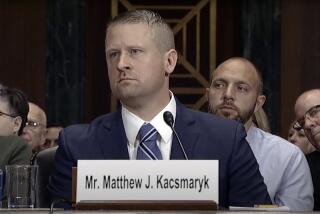Tour Gives Group Straight Facts About Teen Pregnancies
- Share via
FULLERTON — Sex was not something to talk about in Claudia Alvarez’s home, so she found out about it on her own.
“My parents were very strict and girls were not allowed to go out with boys,” Alvarez said. “I think I was acting out a rebellion because of it.”
When her mother found her birth control pills, Alvarez, then 17, lied and said a teacher had given them out to students as samples. Afraid her mother would not believe her if the pills were discovered a second time, she threw them out and soon was pregnant.
Alvarez, 21, told her story Friday to state Sen. Teresa Hughes (D-Inglewood), and an audience of about 30 women who visited a teen-pregnancy program run out of First Baptist Church to hear teens explain why they became pregnant and what could have been done to prevent it.
The Junior League of Orange County arranged the visit to the Fullerton Joint Union High School District-sponsored program and two other teen pregnancy-related programs as a fact-finding tour that precedes today’s state Senate Select Committee hearing on teen-age pregnancy. Hughes chairs the committee, which is holding the 9 a.m. hearing at Cesar Chavez Continuation High School in Santa Ana.
“Just as we looked out for each other in the fires and we looked out for each other in the floods and for our neighbors in the earthquake, we need to do that for our teens and their families,” Hughes said. “Because this is another calamity affecting our society.”
In the past four years, Orange County’s teen birth rate has increased 34%. In 1990, there were 42.1 births per 1,000 teen-agers ages 15 to 19. In 1994, that figure was 59.6 per 1,000. More than 70% of the teen mothers in 1994 were Latinas, even though they comprised just 23.4% of the county’s population.
California leads the nation in births to teen mothers.
The first stop on the tour was Chavez High School’s college preparatory class for teen mothers. There, the women admired 10-day-old Abran Quintana, who wore a teensy-weensy pale blue hat and little green mittens.
The attention finally woke the infant, sending his mother, Hilda Quintana, 18, to the back of the room to quiet him.
“At first, when I got pregnant, I was kind of scared. I was scared to tell my parents,” she whispered, rocking Abran. “But they were really supportive and my husband, Ezequiel, has been a big help.”
Throughout the day, girls in the various programs credited their teachers and classmates for helping them stay in high school and plan for college.
But experts on teen-age behavior and social trends also told the group about family violence and drug use, about girls who are victims of predatory, older men and the profound ignorance among many teens about their sexuality--all factors that contributed to the soaring teen birth rate. The experts used language such as “epidemic,” “plague” and “calamity” to describe the situation.
Eloise Anderson, director of the state Department of Social Services, spoke to the group when it visited Children’s Hospital of Orange County. The women visited the hospital to see babies who were born prematurely and with low birth weights, traits common among infants born to adolescents that increase risk of disease and death.
Most children born to girls ages 15 or younger are fathered by men in their 20s, she told the women. Girls are having sex at younger ages, Anderson said, and their partners are increasingly adult men, instead of their peers.
“The myth we have in our minds--that teen-age liaisons are with other teen-agers--needs to be completely smashed,” Anderson said.
The statistics mean that adolescent girls are in relationships where they have little control and often are coerced into sex, she said. But focusing social efforts, such as job training programs, solely on girls will not break cycles of pregnancy and poverty, she said.
“Why don’t we have programs designed to give (teen fathers) educational training? Why don’t we talk to him and his family about having joint custody?” Anderson said. “What is so terrible about a poor man having custody--especially when you consider that 54% of all child deaths in the U.S. are done by the biological mother?”
Attention is always better than neglect, she said, even when parents are poor.
Attention is what Lisa Pabon, another student in the Fullerton Joint Union High School District program, said she was seeking when she became pregnant at 17.
“I went to a man because I was so alone,” Pabon said. “I lived, off and on, in group homes and foster homes and had a really bad childhood,” she said. Her life has since turned around. Pabon and the father of her child married on Valentine’s Day.
“But how will things be different for your daughter?” Hughes asked. “How will you keep her from following in your footsteps?”
“Oh, it’s totally different, because I had nobody and she has me,” Pabon said. “I’m going to love my daughter.”
More to Read
Sign up for Essential California
The most important California stories and recommendations in your inbox every morning.
You may occasionally receive promotional content from the Los Angeles Times.













